How To Filter Rust From Well Water
Fe and Manganese
 The first step to acquire how to remove iron, manganese, and odour from well water is to understand a piddling almost where iron comes from and the types of iron constitute in well water.
The first step to acquire how to remove iron, manganese, and odour from well water is to understand a piddling almost where iron comes from and the types of iron constitute in well water.
Iron is one of the world'south most plentiful resources, making up at least five per centum of the earth's crust.
In well water you find iron in a dissolved state so h2o may appear clear when first drawn from the tap.
The maximum level of iron recommended in water is 0.iii mg/L. This is the same as proverb 0.three Parts Per 1000000 or PPM. When the level of iron in water exceeds the 0.3 mg/l limit, the water may take a blood-red, brownish, or yellow colour and stain laundry and fixtures.
Manganese is some other metal that leaves stains. Instead of rust stains like iron, information technology leaves a brownish or tea color stain on fixtures, dishes, and laundry. It also has a bitter taste which some describe equally an asphalt or petroleum sense of taste.
Smell and Taste
The water may also accept a metallic gustatory modality and an offensive odor. Water system piping and fixtures can go restricted or clogged. Appliances such as water heaters, dishwashers and washing machines, tin be plugged with rust and sediment.
Iron and manganese also give well water a disagreeable metallic taste. When the fe combines with tea, coffee, and other beverages, it produces an inky, black appearance and a rusty, bad gustation.
Questions to Enquire When Choosing an Iron Filter:
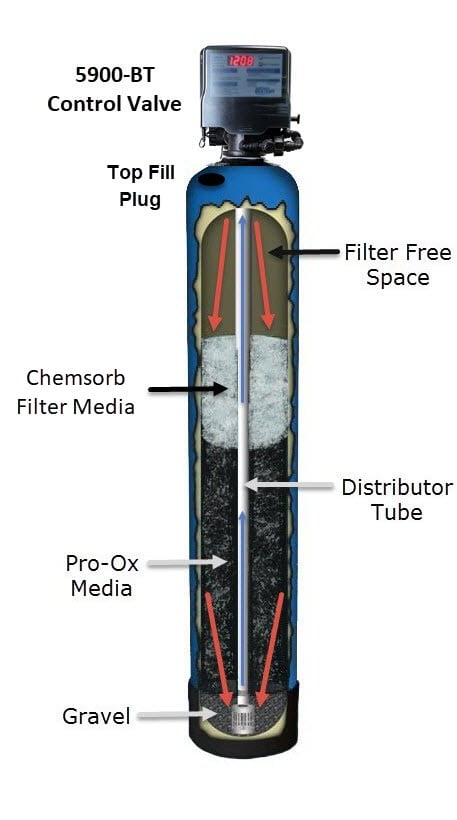 1. What blazon of iron do I have in my water system?
1. What blazon of iron do I have in my water system?
2. What is my well water chemistry? Exercise I have manganese, hydrogen sulfide odor, iron leaner, or tannin in my water..or just iron? What is the pH (acid or element of group i)?
3. What is the source of the fe and/or odor? Is information technology only from the well water or is it likewise from corroding iron pipes or h2o heater?
4. What is the flow rate I have available in gallons per infinitesimal from my well pump or booster pump, to adequately backwash the atomic number 26 filter I choose?
There are 4 chief types of iron or conditions in which iron is found in well water:
- Soluble "Clear Water" Iron
- Insoluble Oxidized "Red Water" Atomic number 26
- Organic Iron
- Iron Bacteria
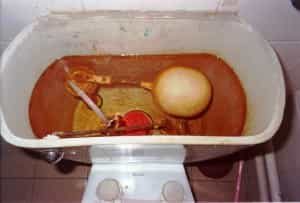
Clear Water Fe
H2o may be clear when first drawn from a hose bib or faucet, merely then turn rusty later. This is iron that is dissolved in the water simply later will plow to rust once information technology is exposed to air.
Exposure to air can happen anywhere or anytime, such as in the toilet, washing auto, or bath. To determine the type of iron, fill a clean white 5-gallon bucket with water. If the water is articulate without a tint or colour, you lot take primarily ferrous iron.
Solution:
Use an oxidizing iron filter such as Pro-OX or other manganese dioxide iron filters to turn the dissolved atomic number 26 to rust form, where it is and so filtered out by the iron filter. Periodic backwash keeps the Pro-OX filter media make clean. Oftentimes these iron filters use aeration to enhance the oxidizing ability of the filter media.
Ruby H2o Iron
Also known every bit ferric iron (rust) this is iron that has already been exposed to some oxidation and is no longer dissolved in the h2o. Rarely does water contain merely ferric iron. Often part or some of the water is oxidized and the rest of the water has clear water fe.
Solution:
Every bit in a higher place, also use an oxidizing fe filter which removes both articulate water atomic number 26 and cerise water iron. If the water was from a storage tank or lake where 100% of the iron was ferric iron (rust) then a sand filter or filter cartridge would remove it.
Organic Atomic number 26
Some waters contain loftier levels of tannins which can enter the well water from the surface. Materials such equally organic leaves, grasses, and other institute materials cause Tannins. These organic compounds can demark with fe.
Solution:
Utilize chlorine bleach, hydrogen peroxide, or ozone gas feed ahead of the iron filter with sufficient contact fourth dimension past using a retentivity tank. Afterward filtering with manganese dioxide atomic number 26 filter, follow with an activated carbon filter. In some cases, if the iron is colloidal (microscopic particles that cannot be easily settled out or filtered) then alum or polymer coagulant feed may be needed to clump the particles into larger particles that can exist filtered.
Atomic number 26 Bacteria
Atomic number 26 bacteria is a general term used to describe various species of bacteria that utilize atomic number 26 to alive and abound. Iron becomes part of their cell walls and the end result is a slimy stringy growth that can exist seen in toilet flush tanks. The stringy growths can also line pipes and build upwards in h2o tanks, fixtures, and appliances.
Solution:
Use chlorine bleach feed to disinfect the water and kill the iron leaner, followed by a Pro-OX atomic number 26 filter. A carbon filter tin be used after the fe filter to remove any residual chlorine. Chlorine bleach is much more effective at eliminating fe leaner than hydrogen peroxide however, ozone is another choice that is effective also.
Use Home Tests to Notice Out What'south In Your Water
 The all-time manner to find out is to do a water test of the water right from the well before it enters the house. If this is not possible, then run the h2o for 5 to 10 minutes so you know the water is coming right from the well.
The all-time manner to find out is to do a water test of the water right from the well before it enters the house. If this is not possible, then run the h2o for 5 to 10 minutes so you know the water is coming right from the well.
A water exam is of import to know which type of atomic number 26 filter to use and if your water is acidic or not.
A water examination will tell you how much iron you have. This noesis helps you to choose the type of approach or system you should use to treat information technology.
Tests should include alkalinity, hardness, hydrogen sulfide, iron, manganese, pH, and total dissolved solids. If the water has a tea colour to information technology or has a yellowish clear color to it, then a tannin test is recommended as well.
You should ever include a pH exam, which indicates if the water is acidic or alkaline. The ideal pH for fe filters to work properly is between 7.0 and 8.0, which is considered neutral and non acidic.
For health-related concerns include a test for full coliform, e-coli (fecal coliform), lead, and nitrate. Complete mineral, metals, and bacteriological tests from a State certified laboratory are recommended; especially if infants and children will be drinking the water.
When the source of your h2o is a public water system and you lot experience fe-related bug, it is of import to contact your water company to determine whether the red water is from the public organization or from the home's plumbing or piping.
Do a Quick Physical Inspection of Your Water and Pipes
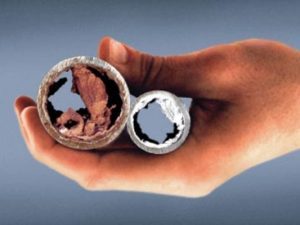 If y'all are experiencing atomic number 26 or rust staining, it is important to determine the source, whether from the well h2o or perhaps from corroding pipes or fixtures.
If y'all are experiencing atomic number 26 or rust staining, it is important to determine the source, whether from the well h2o or perhaps from corroding pipes or fixtures.
Usually, the source of the fe is from the well water itself, every bit iron naturally occurs in many groundwaters.
In some cases, the staining may exist caused by sometime galvanized iron pipage or fixtures which take been corroded, making the water rusty.
Run a hose bib or tap as shut to the well as possible and make full a white 5-gallon bucket or other container and check the color of the water, noting if there is any sediment present.

Notice if there are odors. If y'all olfactory property a "rotten egg" odor, this is hydrogen sulfide gas coming right from your well water.
Manganese can make your water scent like oil or asphalt. In case your water smells similar cucumber or sewage, information technology is commonly due to atomic number 26 and/or sulfur leaner.
Run the hot water from each tap and notice if there is an odor in the hot water that is not in the cold water. This indicates a problem with the water heater.
Iron and sulfur leaner could interact with the anode rod in water heaters. This interaction may result in hydrogen sulfide gas only in the hot water. To solve this, change the anode rod to an aluminum rod.
Even if there'due south no aroma in the cold water but the hot water smells like rotten eggs, then you tin can also add a pint of store-bought hydrogen peroxide to the h2o heater and let it sit for 4 – 6 hours. This volition oft kill the olfactory property for weeks or months. There are special filter strainers that make it like shooting fish in a barrel to add together peroxide to the water without having to accept apart the piping.
Check Your Well Pump Menstruation Rate
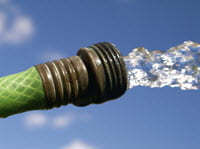 Catamenia rate is defined as simply how many gallons in one minute can be pumped from the well. This is determined mostly by the size of your well pump. It is also affected by the capacity of your well.
Catamenia rate is defined as simply how many gallons in one minute can be pumped from the well. This is determined mostly by the size of your well pump. It is also affected by the capacity of your well.
Sample Ciphering
For instance, if your well pump can fill up a 5-gallon saucepan in sixty seconds direct from the well, yous can consider you have 5 Gallons Per Minute, or 5 GPM.
Nigh homeowners have a standard single-speed submersible pump with a pressure level tank on their private well. This examination is for this standard type of pump and pressure tank. If you have a 'abiding pressure' or variable-speed pump, this examination equally described beneath won't work.
A good flow charge per unit is required in club to exist able to backwash the filter systems properly. An adequate flow rate is besides required in club to provide good water pressure to the home.
Count the gallons "drawn down" from the pressure tank and the time between the cut-in and cutting-off cycle of the well pump. This is known equally pressure tank 'draw downward'.
Easy Steps To Take to Find Our Your Well Pump Period Rate:
1. Get-go, allow the well pump to build up to full force per unit area past running water in the home or from a hose bib or faucet until you hear the well pump boot in or pressure switch points click.
ii. Shut the faucet and brand sure no water is being used in the dwelling. Well pump volition build up pressure for a few minutes and and then pressure level switch will shut off well pump.
three. Next, open a hose bib (besides referred to as a 'spigot' or 'faucet') anywhere nearly or after the pressure tank.
four. Run the water into a v-gallon bucket, noting how many gallons you collect. If bucket fills upwardly, dump out water and keep measuring and filling.
5. Measure the number of gallons fatigued down from the pressure tank until the well pump turns on.
6. When y'all hear the pump plow on, immediately close the hose bib.
7. Time the flow in seconds information technology takes for the well pump to build dorsum up to pressure that is, between the cut-in and cut-out of the pressure switch. The pressure switch turns on the pump at a lower pressure level and turns off the pump when it reaches a higher force per unit area.
8. The formula for determining the flow rate is: gallons are drawn downward (that were measured to a higher place), divided by the seconds required for recovery, and then multiplied past 60:
(Gallons / Seconds) x 60 = Gallons per Minute (GPM) flow rate..
9. For example, if 20 gallons are drawn downwardly and it takes 120 seconds to build force per unit area back up, then: 20 divided by 120 = .166. Then multiply .166 x threescore = ten gallons per minute flow charge per unit.
x. So you have x GPM flow charge per unit.
xi. The side by side 2 posts will explicate the step-by-step procedure on how to remove iron, manganese, and odor from well h2o. You can read the next pace after downloading your iron handling guide.
Want more detailed info on iron removal now? Go the FREE The Complete Guide To Iron Treatment :
Do A Quick Inspection and Examination Your Well H2o
How to remove atomic number 26 manganese and smell from well water? The first footstep is to decide the source and observe out the basic h2o chemistry.
Normally, the source of the iron is from the well h2o itself, as iron naturally occurs in many groundwaters. In some cases, however, the staining may be acquired by one-time iron plumbing which has been corroded, making the water rusty.
The all-time way to find out is to do a h2o examination of the water correct from the well before information technology enters the firm. If this is not possible, and then run the water for 5 to 10 minutes so you know the water is coming correct from the well.
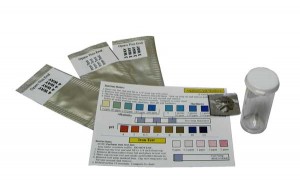
A water test is important to know which type of iron filter to use and if your water is acidic or non. A water test will tell you how much fe you have, which helps in choosing the type of approach or arrangement y'all should use to treat it.
Tests should include alkalinity, hardness, hydrogen sulfide, atomic number 26, manganese, pH, total dissolved solids. If the water has a tea color to information technology or has a yellowish clear color to it, so a tannin test is recommended also.
It should ever include a pH test, which indicates if the water is acidic or alkaline metal. The ideal pH for iron filters to work properly is between vii.0 and 8.0, which is considered neutral and non acidic.
For health-related concerns include a examination for total coliform, E-coli (fecal coliform), and nitrate. If infants and children will be drinking the water, a complete mineral, metals, and bacteriological test from a Country-certified laboratory is recommended.
If the source of water is a public water system and you experience iron-related problems, it is important to contact a utility official to decide whether the cherry water is from the public arrangement or from the abode's plumbing or piping.
Check For Odors in Well Water & Water Heater
 Run a hose bib or tap as close to the well as possible and fill a v-gallon bucket or other container and notice if there are odors. If you lot smell a "rotten-egg" odor, this is hydrogen sulfide gas. If the water smells like oil or asphalt this can be from manganese. If the water smells like cucumber or sewage this is usually a issue of iron and/or sulfur bacteria.
Run a hose bib or tap as close to the well as possible and fill a v-gallon bucket or other container and notice if there are odors. If you lot smell a "rotten-egg" odor, this is hydrogen sulfide gas. If the water smells like oil or asphalt this can be from manganese. If the water smells like cucumber or sewage this is usually a issue of iron and/or sulfur bacteria.
Run the water hot water from each tap and notice if there is an odor in the
hot water, that is non in the cold water. This indicates a trouble with the h2o heater. Atomic number 26 and sulfur bacteria can interact with the anode rod in water heaters, resulting in hydrogen sulfide gas but in the hot water.
Perform a "Toilet Tank Inspection"
Unless your toilet tank is new or has recently been cleaned your toilet affluent tank tin can exist a wealth of useful h2o quality information! Simply lift the encompass and look in. If you see slimy rusty deposits on the sides of the tank, and frothy bubbles in the tank water, this is a adept indication of iron bacteria.
Odor Identification and Solutions
- Does the common cold well water have an odor right out of the well, from an outside hose bib?
- If there is an odor to the water, exercise all the taps in the abode have the odor? Are some taps in the house (such as upstairs, or from a particular bathroom or fixture) have greater odor than others?
- Does the hot h2o have the odor only, with the cold h2o having no odor?
- The all-time way to exam odor is to use a alpine drinking h2o drinking glass or wine glass and have at least two people perform the test past drawing the water and noting the odor.
- How would you characterize the aroma?
| Odors | Source | Possible Remedy |
| Asphalt or oily odor | Manganese | Iron filter that removes manganese ( Pro-OX, MangOX, Greensand, Pyrolox) |
| Oily smell | Petroleum | Oil removal media such OilSorb, followed past activated carbon filtration. |
| Cucumber olfactory property | Atomic number 26 or sulfate-reducing bacteria | Disinfection with chlorine or ozone or peroxide, followed by filtration |
| Earthy or grass olfactory property | Geosmin | Produced past actinomycetes, blue-dark-green algae, and dark-green algae. |
| Garlic scent or gustatory modality | Methane gas | Off-gas into an open storage tank, ventilate well and use caution in treating this problem; methane is flammable |
| Metallic aroma | Atomic number 26, manganese, or copper | Make up one's mind cause past testing water |
| Swimming or Algae odors | Bacteria, organic affair | Disinfection with chlorine or ozone , followed by filtration |
| "Rotten egg" aroma | Hydrogen sulfide gas | Chlorination, aeration, ozone injection, hydrogen peroxide, followed past filtration |
| Sulfur leaner | Chlorination, aeration, ozone injection, hydrogen peroxide, followed past filtration | |
| Sewage odor | Leaking septic tank | Repair or re-locate septic tank or well |
| Bacteria | Disinfection with chlorine or ozone or peroxide, followed past filtration; or repair or relocate septic tank or well |
Pressure Tank with Submersible Well Pump
How Information technology Works:
The submersible pump in well (one) is controlled by the pressure switch (7). When force per unit area in pressure tank (4) drops beneath a preset level (typically twoscore to sixty PSI) the pressure level switch turns on well pump. The well pump continues to run until the pressure in the force per unit area tank builds up, and the pressure switch reaches the maximum pressure setting. The pressure tank contains a pre-charged airbag to moderate pressure in the piping system.
Bank check for Pipage Corrosion & Scale Build-up
Sulfur odors can cause sulfuric acid to build-up in water and corrode pipe and fixtures. Unless your habitation is new, it is important to check for pipe corrosion scale build-up in the pipage. Fortunately, this is not difficult to practise by using one of the following methods:
- Check for signs of blue stains in fixtures, blue stains in toilet tanks, which can indicate copper corrosion, and/or test h2o for copper.
- If you take galvanized iron pipage, look for signs of rust and rust-colored scale in the toilet flush tank.
- If possible, audit the outside of pipes and valves, to run across if yous see any signs of pinhole leaks or corrosion by-products which tin can be crusty, bluish, white or salty looking or rusty. If yous are having whatever plumbing work done on your house, inspect any sections of the pipes that take been cutting to see if in that location is any scale build-upwardly or signs of corrosion.
Identify Pipe Sizes
It is useful to know the size of your incoming pipes. For instance, say you decide you want to install an iron filter system for your house. They come in dissimilar pipage sizes, such as ¾" pipe, 1″ pipe, etc. Generally, you want to make sure you lot become a organisation that volition not restrict the water flow or pressure, and then if you have a 1″ pipe, you would want an iron filter that has 1″ pipe connectors. Knowing what size piping you lot have solves this problem.
It is easy to bank check the size of your pipes. Start, check on the pipe itself, ofttimes it will be labeled or written on the side. If not, the string method which measures the circumference is probably the best mode to decide your pipe size. The circumference is the distance it takes to go around the pipe once.
Using a piece of string nigh 6″ long (or a material tape measure) wrap the string effectually the pipage one time and measure to the nearest ane/8 of an inch. Once you lot have constitute the circumference, use the nautical chart below to observe your pipe or tube size.
Learning how to remove atomic number 26 manganese and olfactory property from well water is non difficult if you follow a few simple steps!
The third and concluding part of this iii – role series talks almost what types of systems piece of work best and more than item on how to remove iron manganese and odor from well h2o.
Now that you know your basic water chemistry and well menstruum rate, information technology's fourth dimension to choose the lowest cost and the best solution to treat your water.
Oxidizing Fe Filters
Fe filters oxidize the dissolved ferrous iron in h2o to an insoluble particle. Then the filter traps the fe (rust) in the iron filter media. A periodic backwash cleans out the rust & flushes the filter media clean. Various types of iron filter media are bachelor including Birm, including Greensand, Pro-OX, Filox™, & Pyrolox™.
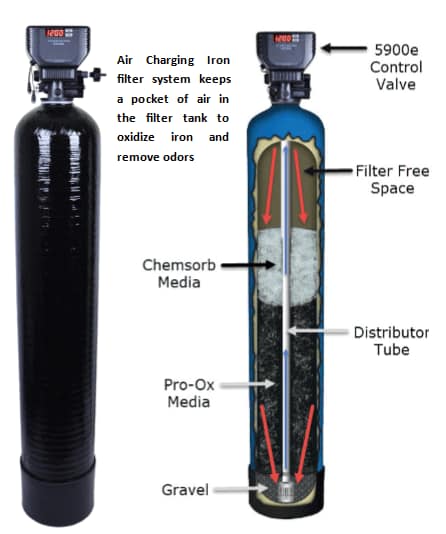
Oxidizing iron filters apply either air, potassium permanganate, chlorine or ozone to aid the filter media in oxidizing the iron. Some brands are Filox™, Pro-OX™, and Pyrolox™. They are all solid manganese dioxide media. Almost fe filter media uses a thin coating of manganese dioxide over some other type of filter media. Solid manganese dioxide media are the gold standard for atomic number 26 filtration media. The media lasts for many years, ofttimes 15 to 20 years and these systems can filter the water at a faster rate.
The solid manganese dioxide types of filter media are the gold standard for iron filtration media. The media lasts for many years, oftentimes 15 to 20 years. These systems can filter the water at a faster charge per unit.
Which Type Of Iron Filter is Best?
For all-time results, lowest maintenance, and longer life nosotros recommend a high purity manganese dioxide filter media such as Pro-OX Iron Filters. Our company has customers with iron filters that have the same manganese dioxide media filters installed over 10 years ago. The filter media lasts many years longer than greensand, or other manufactured, coated filter media.
If sulfur odors or manganese are nowadays, we recommend that y'all use a chlorinator or ozone injection system in forepart of the iron filter. The Air-Charger type (Pro-OX-AIR) systems work the best if y'all have iron and sulfur odor, simply no manganese or fe bacteria,
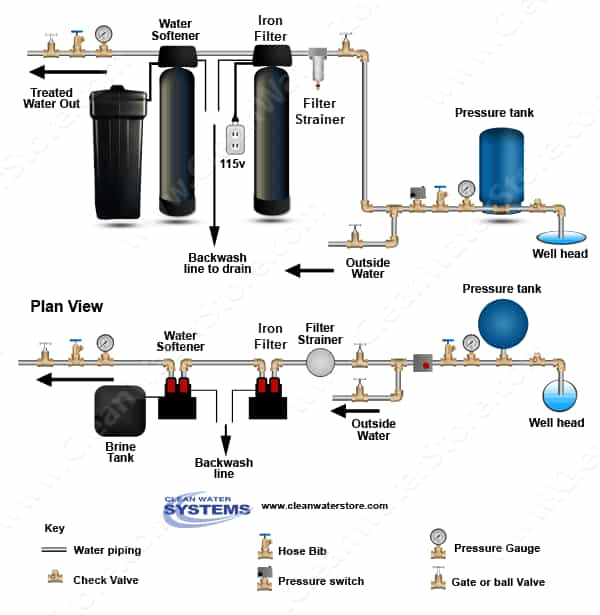
Air Charging Atomic number 26 Filters Remove Iron, Manganese and Sulfur Odor
The air charge iron filter, as a single tank system, is an efficient and toll-effective system for the removal of iron and sulfur.
When used with a solid manganese dioxide filter media such as Pro-OX, information technology tin can last for many years with little or no maintenance. No chemicals are required.
This type of iron filter maintains an "air pocket" in the peak of the tank while the organization is in service. Equally the h2o passes thru the air pocket, iron and sulfur are oxidized. Additionally, dissolved oxygen is added to the water. The iron filter media bed then removes the iron and sulfur from the water.
Air charger-blazon iron filters can generally remove upwards to 8 ppm hydrogen sulfide and up to ten ppm Iron. The aftermath removes accumulated iron and replenishes the filter media bed and adds a fresh air pocket to the system.
The unique 5900e control valve allows the air pocket to be replenished each night, without having the atomic number 26 filter go through a complete backwash.
Other Air-Charger Iron Filters must go through a complete backwash each night, in order to replenish the air. This wastes thousands of gallons of water each year.
The 5900e-AIR saves water by being able to depict in air, independent of the backwash. The Pro-OX 5900 AIR is able to put the whole oxidation process inside 1 tank, keeping maintenance costs and downtime to a minimum.
This type of iron filter is one we recommend most frequently as information technology works best for nigh of our customers and is the easiest to maintain.
When Iron Bacteria or High Levels of Manganese or Sulfur Is Present Use Chlorine Injection OR Ozone Injection
If manganese is present over 0.2 PPM, we recommend a chlorine feed (the water be chlorinated) ahead of the iron filter. A small-scale amount of chlorine is automatically injected by a chlorine pump prior to the existing well pressure tank. At these low levels of chlorine (nether 10 ppm) the pressure tank is not afflicted by the chlorine.
The contact tank allows some time for the chlorine to work and dissipate. Every bit the water flows into the Pro-OX filter all fe, manganese and hydrogen sulfide are filtered out. After the Pro-OX iron filter, a carbon filter removes all trace of chlorine.

Air Compressor Systems Aid in Removing Iron and Manganese
This type of iron filter uses a compressor to inject air into the h2o. This system uses a separate tank to inject and aerate the water and is highly effective at eliminating sulfur odors and oxidizing higher levels of fe. It volition non remove atomic number 26 bacteria, but it does offer a higher level of aeration than a standard Air-Charger type iron filter. The drawback is higher price, and for most home well water applications, the Air-Charger is all that is needed.
I upshot of the air compressor is that the h2o itself does become saturated with tiny air bubbles. Often when first drawing the h2o in a glass, the h2o may announced white, merely information technology instantly clears as the air leaves the water.
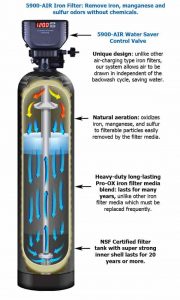
You can use air compressor systems with various iron filter media such every bit Birm, Greensand, and Pro-OX. We recommend Pro-OX manganese dioxide filter media as it lasts for many years. With Pro-OX (too Greensand) a chlorinator or ozone pre-treatment system could always exist added later if iron bacteria were present.
The air compressor aeration tank is typically installed after the pressure tank and before the fe filter. The compressor can be wired so it turns on each fourth dimension the well pump runs and re-charges the aeration tank with fresh air. It tin also be set up on a timer so it refreshes the aeration tank 1 or more times a day automatically.
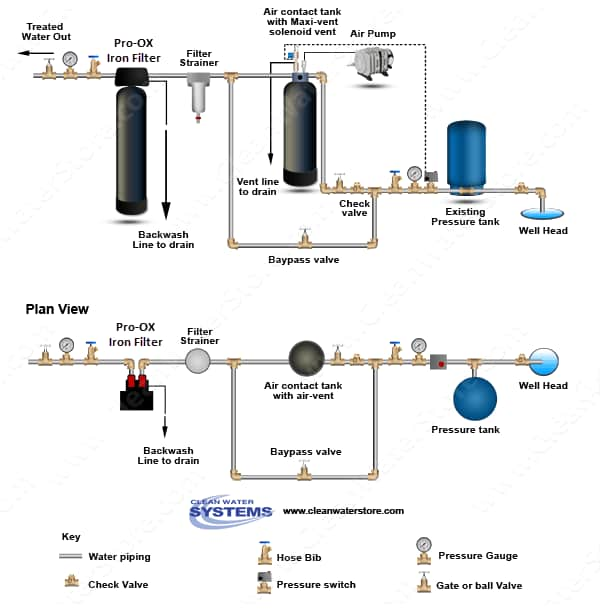

How To Filter Rust From Well Water,
Source: https://www.cleanwaterstore.com/blog/how-to-remove-iron-manganese-and-odor-from-well-water-step1/
Posted by: laneusety1965.blogspot.com

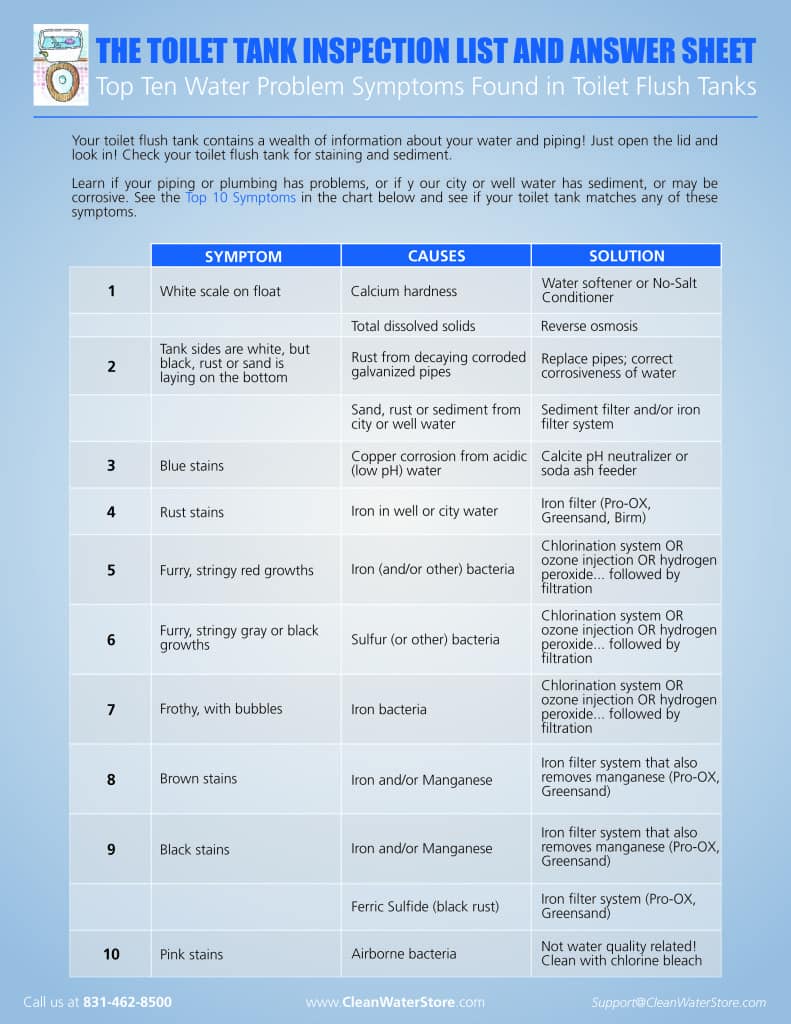

0 Response to "How To Filter Rust From Well Water"
Post a Comment